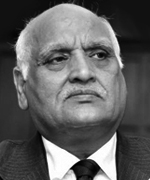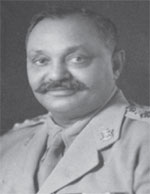Guts, Grit and Glory | The Indian Schindler of Jamnagar
 Maj. Gen. Raj Mehta (retd)
Maj. Gen. Raj Mehta (retd)
It was the summer of 2002. A Brigadier level staff officer in the Military Operations, Director, Army HQ, I was informed after a briefing to the Army Chief that I would accompany him to Israel on an official visit a few days later and coordinate the visit with my Israeli counterparts.
The visit had specific military content but the evenings had cultural content, one keenly-anticipated being a visit to the Yad Veshem Holocaust Museum, Jerusalem. That two hour visit impacted our delegation deeply, from reception by a lady guide dressed in all black to her exacting description of the visit’s purpose and the protocol for going through the largely black-and-white displays and exhibits related to the five million Jewish victims of the Holocaust...We saw a hill of just spectacles of victims...another of teeth with gold fillings...an immensely saddening hill of dolls, some broken, some blood stained... and so much more.
What hit us with an Armageddon of emotions and grief after we entered a huge, dark cavern was suddenly coming face-to-face with a larger than life black-and-white portrait of a little coat wearing angelic Jewish girl with the world’s most cherubic, innocent, infectious smile. She was clutching her pretty doll by its arms. There was a stark candle lighting up the little girl’s beatific face. Looking around the cavern slowly, we realised that the candle flame was replicated in millions of convex glass pieces embedded into the cavern walls and ceiling...five million glass pieces. In the background, a haunting Jewish lament played...an ode to devastating loss of three generations of Jews. A stark line under the girl’s portrait informed viewers that, shortly after the picture was taken, the girl was exterminated in Auschwitz...Birkenau...Treblinka Death Camp...I cannot recall which. What mattered was the proud, delicate-yet-strong sensitive face of our guide. There was nothing she said; her silence said it all. We had entered the souls of the victims and were deeply moved to silence.
An Indian Connection
India, like Israel, is an ancient country with huge inherent strength, tolerance and secular ideals in its DNA with the motto of Atithi Devo Bhava (The Guest is God) and Vasudhaiva Kutumbakam (The world is one family). It has been through serial genocides, the most devastating being the Partition Holocaust of 1947 and yet, like Israel, has come out resilient and persevering. What is more important is that in India, the core DNA of treating the world as a family; treating guests like God are still cherished ideals.
One sterling example of such peerless DNA was Maharaja ‘Jam Sahib’ Capt (later Hony Lt Gen) Digvijaysinhji Ranjitsinhji Jadeja of Jamnagar (Nawanagar), Gujarat. Around 1200 orphaned Polish children for whom he was ‘Bapu’ (Father) during the Great War years of 1942-1947 never forgot “the good King” who created Little Poland for them in his Kingdom in Gujarat; facilitated similar such habitats for other Polish children/parents in neighbouring Maharashtra - because he had the power and position to do so; and the humanism.
This story is about this unusual King whom his mischievous Polish children affectionately nicknamed “Big Jam” who visited them with toffees and money in his pockets. However, before revealing his story, let’s examine why in retrospect, the survivors among those he benefited and their ancient country of Poland salute the good King; their Bapu--as an Indian Schindler.
The Indian Schindler
In real life, German businessman and Nazi sympathiser Oskar Schindler was, to start with, a vain and greedy German businessman; a suave man-about-town with many Nazi connections which he exploited for financial gain. He became an unlikely humanitarian when face-to-face with an incident of horrendous Nazi barbarism. It drove him to provide some Jews refuge under false pretexts--in a conquered Poland where Hitler’s orders were to eliminate Jews of all genres.

Post his conversion to humanism, he saved over 1100 Jews from certain extermination in the gas chambers of Auschwitz/ Birkinau/ Treblinka. His remarkable turnaround was captured in Schindler's List, an epic 1993 American historical film directed by Steven Spielberg, a Jew. It stars award-winning Liam Neeson as Schindler and Ben Kingsley as Schindler's Jewish accountant. Listed among the greatest films ever made for its “tone, acting, atmosphere and Spielberg's direction”, the film won seven Academy Awards; was nominated for more and is 8th on the list of the 100 best American films ever made. The opening scene in this primarily black-and-white Holocaust film features a scene in Technicolor in which a Jewish family is shown observing Shabbat rituals with ceremonial candles being lit. The colour then fades out, giving way to a grey world in which smoke and flames symbolize Jewish bodies being burnt at the Death Chambers. Only at the end when Shabbat is observed again do the images of lighted candles regain their warmth. For Spielberg, they represented "just a glint of colour; a glimmer of hope." The two scenes bracket
Subscribe To Force
Fuel Fearless Journalism with Your Yearly Subscription
SUBSCRIBE NOW
We don’t tell you how to do your job…
But we put the environment in which you do your job in perspective, so that when you step out you do so with the complete picture.








